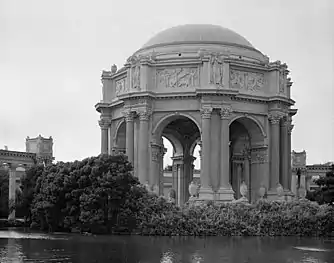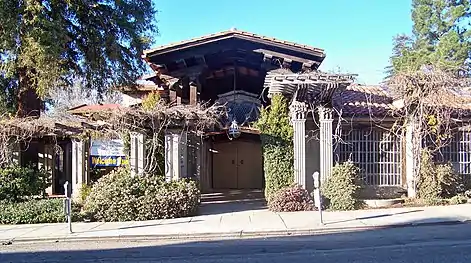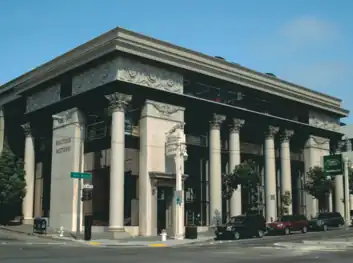Bernard Maybeck | |
|---|---|
.jpg.webp) Maybeck in 1919 | |
| Born | February 7, 1862 New York City, US |
| Died | October 3, 1957 (aged 95) |
| Alma mater | École nationale supérieure des Beaux-Arts |
| Occupation | Architect |
| Awards | AIA Gold Medal (1951) |
Bernard Ralph Maybeck (February 7, 1862 – October 3, 1957) was an American architect in the Arts and Crafts Movement of the early 20th century. He was an instructor at University of California, Berkeley.[1] Most of his major buildings were in the San Francisco Bay Area.
Biography
Maybeck was born in New York City, the son of a German immigrant and studied at the Ecole des Beaux Arts in Paris, France.[2] He moved to Berkeley, California, in 1892. He taught engineering drawing and architectural design at University of California, Berkeley from 1894 to 1903, and acted as a mentor for a number of other important California architects, including Julia Morgan and William Wurster. In 1951, he was awarded the Gold Medal of the American Institute of Architects.
Maybeck was equally comfortable producing works in the American Craftsman, Mission Revival, Gothic revival, Arts and Crafts, and Beaux-Arts styles, believing that each architectural problem required development of an entirely new solution. While working in the office of A. Page Brown in San Francisco, Maybeck probably contributed to the Mission Style California Building at the 1893 World's Columbian Exposition in Chicago and the first Mission Style chair, designed for the San Francisco Swedenborgian Church.[3]
Many of Maybeck's buildings still stand in his long-time home city of Berkeley. The 1910 First Church of Christ, Scientist, Berkeley is designated a National Historic Landmark and is considered one of Maybeck's finest works. A number of his works are listed on the National Register of Historic Places.[4]
In 1914, Maybeck oversaw the building of the Maybeck Recital Hall in Berkeley, California. Maybeck also designed the domed Palace of Fine Arts in San Francisco as part of the 1915 Panama-Pacific International Exposition, and for the same fair he carried out his vision of the lumberman's lodge, "House of Hoo Hoo", made of little more than rough-barked tree trunks arranged in delicate harmony. The Palace of Fine Arts was seen as the embodiment of Maybeck's elaboration of how Roman architecture could fit within a California context. Maybeck said that the popular success of the Palace was due to the absence of a roof connecting the rotunda to the art gallery building, along with the absence of windows in the gallery walls and the presence near the rotunda of trees, flowers and a water feature.[5]
One of Maybeck's most interesting office buildings is the home of the Family Service Agency of San Francisco, offices at 1010 Gough Street. This building, constructed in 1928, is on the city's Historic Building Register and still serves as Family Service headquarters. Some of his larger residential projects, most notably a few in the hills of Berkeley, California (see esp. La Loma Park), have been compared to the ultimate bungalows of the architects Greene and Greene.[6] In 1928, the Harrison Memorial Library was designed by California architect Maybeck in a Spanish Eclectic style and built by Michael J. Murphy.[7][8]
Maybeck had many ideas about town planning that he elaborated throughout his career. As a citizen of Berkeley from the 1890s, he was intimately involved in the Hillside Club. His associations and work there helped evolve ideas about hillside communities. Maybeck developed a number of firm beliefs in how civilization and the land should relate to each other.[9] Two overriding principles would be: 1) the primacy of the landscape - geology, flora and fauna were not to be subdued by architecture so much as enhanced by architecture 2) roads should pattern the existing grade and not be an imposition upon it. There were other principles he would elucidate, such as a shared public landscape, but these were key, and helped Berkeley evolve into a paradigm for hillside living that was organic and unique.[10] Maybeck's visions for communities in the East Bay were also a conscientious counterpoint to across the bay where in San Francisco city planning was much more conventional, forced, and regimented into expansive grids of streets. Its grids, imposed in places on very steep grades, resulted in extremely steep streets, sidewalks and urban transitions, some almost comically so.
Maybeck was not doctrinaire however. His views reflected his wide interests and experience. Maybeck would play with more formal Beaux Arts planning principles on less steep grades, as his Palace of Fine Arts and numerous proposals for the University of California, Berkeley campus, San Francisco, and the Loch Lin General Plan for Principia College in Missouri, would reflect.[11]
He also developed a comprehensive town plan for the company town of Brookings, Oregon, a clubhouse at the Bohemian Grove, and many of the buildings on the campus of Principia College in Elsah, Illinois.[12][13]
A lifetime fascination with drama and the theatre can be seen in much of Maybeck's work. In his spare time, he was known to create costumes, and also designed sets for the amateur productions at Berkeley's Hillside Club.
Bernard Maybeck died in 1957 and is buried in the Mountain View Cemetery in Oakland, California.
Works
 Palace of Fine Arts in San Francisco
Palace of Fine Arts in San Francisco First Church of Christ, Scientist (Berkeley, California), widely considered Maybeck's masterpiece.[14][15]
First Church of Christ, Scientist (Berkeley, California), widely considered Maybeck's masterpiece.[14][15] Lynwood Pacific Electric Railway Depot, Los Angeles, California
Lynwood Pacific Electric Railway Depot, Los Angeles, California Maybeck's automobile dealership on Van Ness currently houses British Motor Car Distributors.
Maybeck's automobile dealership on Van Ness currently houses British Motor Car Distributors.
Notable works include:
- Charles Keeler House & Studio (house 1895, studio 1902) — Maybeck's first private client, Berkeley Hills, Highland Place, North Berkeley, California.[16]
- Swedenborgian Church (1895) — 3200 Washington Street at Lyon Street, Pacific Heights, San Francisco, California, NRHP-listed.[4][17]
- Wyntoon, with architect Julia Morgan (1898−1902) — private estate of Phoebe Apperson Hearst−Hearst family, rural Siskiyou County, California.
- Boke House (1902) — for George Henry Boke (1869–1929), at 23 Panoramic Way, Panoramic Hill Historic District, Berkeley, California.[18][19]
- Faculty Club (1902, later additions by Maybeck and John Galen Howard) — University of California, Berkeley campus, NRHP-listed.[4][20][21]
- Grove Clubhouse−Maybeck Lodge (1903–04) — Bohemian Grove, the Bohemian Club 'campground' on the Russian River, Monte Rio, California.[22][23]
- Howard B. Gates House (1904) — Mission Revival style, at 62 South Thirteenth Street, San Jose, California.[24]
- The Outdoor Art Club (1904) — 1 West Blithedale Avenue, Mill Valley, Marin County, California, NRHP-listed.[4][25]
- Hillside Club (1906, rebuilt 1924) — Cedar Street, North Berkeley, a city designated Berkeley Landmark.[26] The original 1906 clubhouse was destroyed in the 1923 Berkeley Fire. Maybeck's brother-in-law, John White, designed the current clubhouse in 1924.
- Andrew Cowper Lawson House (1908) — 1515 La Loma Avenue, Berkeley, California; a Berkeley Landmark[27][28]
- Goslinsky Residence (1909) — 3233 Pacific Avenue, San Francisco, California
- Roos House (1909) — Tudor Revival and other styles, at 3500 Jackson Street at Locust, Pacific Heights, San Francisco, California, NRHP-listed & San Francisco Landmark.[4][29]
- First Church of Christ, Scientist (Berkeley, California) (1910) — 2619 Dwight Way, Berkeley, California, NRHP-listed[4]
- Rose Walk (1912) — public outdoor stairway and landscape, La Loma Park neighborhood in North Berkeley, California.[30]
- Chick House (1913) — for Guy Hyde Chick (1868–1930), in Chabot Canyon of the Berkeley Hills, at 7133 Chabot Road, Oakland Hills district of Oakland, California.[31][32]
- Temple of Wings (1914, designed in 1911) for Charles Calvin Boynton and Florence Treadwell Boynton, in the La Loma Park neighborhood at 2800 Buena Vista Way, Berkeley, California[33][34]
- Kennedy-Nixon house (1914, rebuilt 1923) — 1537 Euclid Avenue, La Loma Park district, North Berkeley, Berkeley, California.[35]
- Maybeck Recital Hall (1914, rebuilt 1923) — part of Kennedy-Nixon house complex, Euclid Avenue at Buena Vista Way, North Berkeley.[36]
- Palace of Fine Arts (1915, rebuilt 1965) — Panama-Pacific Exposition building, 3301 Lyon Street, Marina District, San Francisco, California, NRHP-listed.[4]
- Parsons Memorial Lodge (1915) — Sierra Club lodge at Tuolumne Meadows, Yosemite National Park, California, NRHP-listed.[4]
- Erlanger House (1916) —270 Castenada Avenue, Forest Hill neighborhood, San Francisco, California.[37]
- Lynwood Pacific Electric Railway Depot (1917) — Lynwood, South Los Angeles region, California.
- Byington Ford House (1922) — Pebble Beach, California[38]
- Bernard Maybeck house and studio (1924) — architect's own residence and studio, Maybeck Twin Drive, La Loma Park district, North Berkeley, California.[39]
- Phoebe Hearst Gymnasium for Women, with architect Julia Morgan (1927) — Oxford Street, University of California, Berkeley campus, NRHP-listed.[4]
- Earle C. Anthony Packard Showroom (1927) — Beaux-Arts style, on Van Ness Avenue at Ellis Street, San Francisco, the present day British Motors dealership, San Francisco Landmark.[40]
- Earle C. Anthony House (1927) — Medieval, Gothic, Spanish and Tudor Revival elements, at 3431-3441 Waverly Drive, Los Feliz district, Los Angeles, California.[41][42][43]
- Later the Countess Bernardine Murphy Donohue estate (c.1950−c.1970) with gardens designed by Florence Yoch & Lucile Council.[44] Later the Convent of the Sisters of the Immaculate Heart of Mary, and the Cardinal Timothy Manning House of Prayer for Priests complex (1975−2011).[45][46]
- Earle C. Anthony Packard Showroom (1928), remodel of 1911 Greene and Greene design — on Olympic Boulevard and Hope Street, South Park district of Downtown Los Angeles, the present day Packard Lofts condos.[47]
- Associated Charities of San Francisco Building (1928) — 1010 Gough Street at Eddy, San Francisco, the present day Family Service Agency of San Francisco center, San Francisco Landmark.[48]
- Historic districts with Maybeck designed works include
- Panoramic Hill Historic District — in the Berkeley Hills, in Berkeley and Oakland Hills, Oakland, California, NRHP-listed.
- Maybeck designed residences include the Boke House (1902) at 23 Panoramic Way[4]
- Principia College Historic District — River Road, Elsah, Illinois, NRHP-listed.[4]
- Maybeck designed the 'English village' campus master plan, and campus buildings including the Colonial Revival style Chapel (1931-34) at 1 Maybeck Place.[49]
- Professorville Historic District — roughly bounded by Embarcadero Road, Addison Avenue, and Emerson and Cowper Streets, in Palo Alto, California, NRHP-listed.[4][50]
- Maybeck designed the "Sunbonnet House" (1899, restored 2004) for Emma Kellogg.[51]
- Tahoe Meadows Historic District (founded 1924) — first planned open space community in Lake Tahoe region, on US 50 between Ski Run Boulevard and Park Avenue, South Lake Tahoe, El Dorado County, California, NRHP-listed.[4][52][53]
References
- ↑ Cardwell, Kenneth (1977). Bernard Maybeck; Architect, Artisan, Artist. Salt Lake City: Peregrine Smith. pp. 38–40.
- ↑ One of his early jobs was with the architectural firm of Carrere and Hastings working as a draftsman on the monumental Ponce de Leon Hotel built for Standard Oil magnate Henry Flagler in St. Augustine, Florida. Maybeck's father also worked on the project, as a woodcarver "Two of San Francisco's best-known landmarks were built by Germans: Joseph Strauss designed the 1937 Golden Gate Bridge, and Bernard Maybeck, son of a German immigrant, designed the Palace of Fine Arts."
- ↑ Freudenheim, Leslie. Building with Nature: Inspiration for the Arts & Crafts Home (Gibbs Smith, 2005)163ff and 60–68
- 1 2 3 4 5 6 7 8 9 10 11 12 13 "National Register Information System". National Register of Historic Places. National Park Service. July 9, 2010.
- ↑ Macomber, Ben. The Jewel City, 1915, pp. 25, 101–102.
- ↑ See comparison of Maybeck and Greene and Greene bungalows in Freudenheim, Leslie, op. cit., 186 and 154ff.
- ↑ Seavey, Kent (2007). Carmel, A History in Architecture. Carmel-by-the-Sea, California. p. 114. Retrieved 2022-01-16.
{{cite book}}:|work=ignored (help)CS1 maint: location missing publisher (link) - ↑ Hale, Sharron Lee (1980). A tribute to yesterday: The history of Carmel, Carmel Valley, Big Sur, Point Lobos, Carmelite Monastery, and Los Burros. Santa Cruz, California: Valley Publishers. p. 67. Retrieved 2022-01-19.
- ↑ Freudenheim, Leslie, op. cit., 100.
- ↑ The Arts and Crafts Movement in California; Living the Good Life, Kenneth R. Trapp et.al., Abbeville Press, 1993, p.60
- ↑ Bernard Maybeck at Principia College; The Art and Craft of Building, Robert Craig, Gibbs Smith, 2004 p.112
- ↑ Vernacular Language North. Bernard Maybeck, Grove Clubhouse, Bohemian Club of San Francisco. Archived 2003-09-01 at the Wayback Machine Retrieved March 4, 2009.
- ↑ KETC: Living St. Louis: The Architecture of Principia College
- ↑ "Maybeck And His Work". Archived from the original on 2011-07-21. Retrieved 2011-03-29.
- ↑ Berkeley Landmarks :: First Church of Christ, Scientist
- ↑ Berkeleyheritage.com, Berkeley Landmarks: Charles Keeler House & Studio, photo gallery + info.
- ↑ Noehill.com San Francisco Landmarks: Swedenborgian Church (1895), 3200 Washington Street at Lyon Street
- ↑ Great Buildings Architecture: Boke House, by Bernard Maybeck (1902), Bay Regional shingle style, photo gallery + info.
- ↑ Berkeleyheritage.com: "Maybeck's Boke House: Made by One Crusader for Another"
- ↑ Berkeleyfacultyclub.com: The Faculty Club at UC Berkeley, website
- ↑ Berkeleyfacultyclub.com: UC Berkeley Faculty Club History Archived 2015-09-06 at the Wayback Machine
- ↑ Mix, Robert. "Bernard Maybeck: (1902–1905)". Vernacular Language North. Archived from the original on September 1, 2003. Retrieved September 4, 2012.
- ↑ "Maybeck Lodge, Bohemian Grove". Calisphere. University of California. Retrieved September 4, 2012.
- ↑ HABS−Historic American Buildings Survey: Howard B. Gates House, San Jose, Santa Clara County, CA
- ↑ "The Outdoor Art Club, Mill Valley: History". Archived from the original on 2018-02-13. Retrieved 2015-06-30.
- ↑ Hillside Club of Berkeley: History
- ↑ "Maybeck Made La Loma Park His Own Country". Berkeley Architectural Heritage Association (BAHA). Retrieved 2023-07-03.
- ↑ "A Tale of Two Houses". Modern Magazine. 2017-10-19. Retrieved 2023-07-03.
- ↑ Noehill.com San Francisco Landmarks: Roos House (1909), 3500 Jackson Street, Presidio Heights, photo gallery + info.
- ↑ Rose Walk, by Bernard Maybeck (1912), pedestrian street, public stair, and landscape, photo gallery + info.
- ↑ Buildings Architecture: Chick House, by Bernard Maybeck (1913), Bay regional shingle style, photo gallery + info.
- ↑ Berkeleyheritage.com: Guy Hyde Chick: The Man Behind the Chick House", photos + info.
- ↑ Cerny, Susan (January 28, 2002). "The Temple of Wings 2800 Buena Vista Way, Berkeley, CA". Berkeley Architectural Heritage Association (BAHA).
- ↑ Ketcharp, Diana (1991-10-07). "On the Wings of Uncertainty". Oakland Tribune. pp. B1, B2. Retrieved 2022-11-28 – via Newspapers.com.
- ↑ Berkeleyside.com, "Landmark Bernard Maybeck Kennedy-Nixon house for sale in Berkeley" (2012).
- ↑ Maybeck Studio for the Performing Arts (Maybeck Recital Hall), part of Maybeck's Kennedy-Nixon compound.
- ↑ Dwell.com, "A Century-Old Arts and Crafts Home by Bernard Maybeck Lists for $4.25M"] (2019).
- ↑ "Architect and engineer". Architect and Engineer, Inc. San Francisco. 1905. Retrieved 2022-04-21.
- ↑ Great Buildings Architecture: Maybeck House and Studio, by Bernard Maybeck (1924), Bay Area Modern style, photo gallery + info.
- ↑ Noehill.com, San Francisco Landmark #153: Earle C. Anthony Packard Showroom
- ↑ Michael Locke @ Flickr: Earle C. Anthony House, architect Bernard Maybeck (1927), info + image #1.
- ↑ Michael Locke @ Flickr: image #2
- ↑ Michael Locke @ Flickr: image #3
- ↑ Murphy Donohue estate gardens − "Landscaping the American dream: the gardens and film sets of Florence Yoch, 1890-1972"; by James J. Yoch; H.N. Abrams, 1989.
- ↑ LA Times: Cardinal Timothy Manning House of Prayer for Priests, founder John D. McAnulty (April 2009) (Earle C. Anthony estate).
- ↑ LA Curbed: "Katy Perry and Elderly Nuns Fighting For Control Of Spectacular Los Feliz Convent" (June 2015) (Earle C. Anthony estate).
- ↑ Los Angeles Downtown News: "A Heap of Downtown History In Neon 'Packard' Sign", Earle C. Anthony Packard Showroom.
- ↑ Noehill.com, San Francisco Landmark #111: Associated Charities of San Francisco / Family Service Agency of San Francisco Building
- ↑ HABS−Historic American Buildings Survey: Principia College, Chapel, 1 Maybeck Place, Elsah, Jersey County, IL
- ↑ NPS.gov: Professorville Historic District, Palo Alto, Santa Clara County, California
- ↑ The Sunbonnet House, 1061 Bryant Street, Professorville Historic District, Palo Alto, CA
- ↑ Tahoemeadows.org: Tahoe Meadows National Historic District
- ↑ Tahoemeadows.org: Photo gallery
External links
Bernard Maybeck.
| Library resources about Bernard Maybeck |
- Maybeck Foundation—a non-profit preservation and education foundation Archived 2006-12-05 at the Wayback Machine
- Maybeck at Principia College
- A High School named after Bernard Maybeck in Berkeley
- Bernard Maybeck at Find a Grave
- Sargeant, Winthrop (17 May 1948). "Bernard Maybeck". Life. pp. 141–153. Retrieved 12 April 2018.
Selected works
- Maybeck's Work at Brookings Oregon and a selection of his essays and drawings
- Pictures of the First Church of Christ, Scientist in Berkeley
- Pictures of Family Service Agency headquarters in San Francisco
- FSA Building on list of SF Landmarks
- Photograph of the interior of Maybeck Lodge at the Bohemian Grove
- Roy Flamm Photographs of Buildings Designed by Bernard Maybeck, ca. 1950-1955, The Bancroft Library
- Archival holdings of the Environmental Design Archive of UC Berkeley